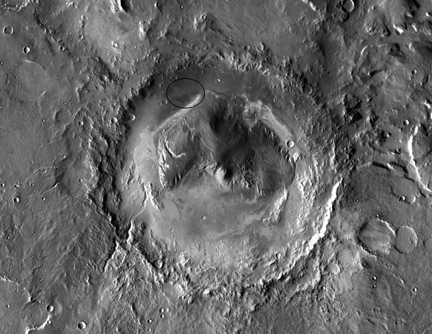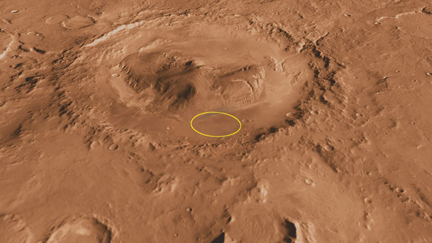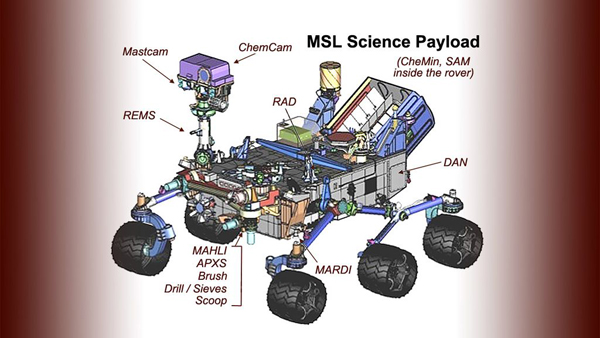The Mars science gear on Curiosity
Editor's note: The following story was written for CNET and is reposted here with permission. Pictures have been updated to reflect current planning and progress.
By WILLIAM HARWOOD
CBS News
KENNEDY SPACE CENTER, FL--NASA's Mars Science Laboratory rover, the most scientifically powerful robotic lander ever built, will use a suite of sophisticated instruments to search for carbon compounds and the geological markers that might indicate whether ancient, once-wet environments were ever habitable.
Scientists currently are assessing four potential landing sites for the rover's August 2012 arrival at the Red Planet that offer the best chance for a successful landing and the most scientifically promising terrain. (For the main story in this package, see "On Mars, satisfaction awaits Curiosity.")
"What we know going into this is every one of our landing sites contain minerals that also contain water," said John Grotzinger, the MSL project scientist. "And at several of our landing sites, we also see evidence for the flow of water across the ancient surface.
"We've got about 10 years of backing from other missions that allow us to pinpoint places where we're no longer asking the question 'Is there water there?' We know that water was there. Now we're going to be asking more specific questions about whether or not those environments that contained water were the types of environments that would have supported microbial life."
The Mars Science Laboratory rover, named "Curiosity" in a student naming contest, features a robot arm, high-resolution cameras, and an integrated suite of instruments making up a compact science payload that weighs 165 pounds. In contrast, the five instruments aboard the Spirit and Opportunity rovers weighed about 20 pounds.
In a major boost over the earlier rovers, MSL will be powered by a radioisotope thermoelectric generator, using the heat of radioactive decay--not solar power--to generate electricity.
Using that generator, Curiosity is designed to operate for at least two Earth years and to rove at least 12 miles. While actual mileage will vary, engineers expect it to rove well beyond its design specification, both in time and distance.
But the rover's scientific instruments are what researchers hope will begin answering some of the toughest questions about Mars and its past: how much water once existed, and did conditions ever support the evolution of life?
"There are a significant number of people in the community who really believe there was a northern ocean," Grotzinger said. "There is a significant number of people who believe that water never really accumulated for long periods of time on the surface."
Two of the potential landing sites, Grotzinger said, show "superb evidence" for the accumulation of water in a lake: "How long that lake existed, we're not sure. But what we know is that if we were to go to these landing sites, once and for all we're going to actually get to touch the rocks that formed in these lakes."
One suite of instruments, known as the Sample Analysis at Mars, or SAM, package will be used to analyze soil and rock fragments delivered by the lander's robot arm. It includes a gas chromatograph, a mass spectrometer, and a laser spectrometer to look for carbon compounds--elements critical to life--and to measure isotope ratios, which will shed light on the history and distribution of water and the evolution of the Martian atmosphere.
"You've got to have water for life as we know it," Grotzinger told CNET. "The second thing is you need a source of energy...And then the important thing is, you need the fundamental building block, which is carbon."
Until recently, there was no direct evidence of carbon compounds on Mars. Now, Grotzinger said, there are two lines of evidence.
"One is measurements from Earth that suggests there may be methane in the atmosphere," he said. "And the second thing is that based on orbiter missions, people have discovered rocks that are made out of carbonate minerals. So you see it in rocks, you see it in the atmosphere, so it's reasonable to propose that we have all of the three key ingredients that we need in order for life to exist.
Then there's the really big question.
"Now, whether or not life originated on Mars, that verges more on philosophy, really. We don't know how life originated on Earth," Grotzinger said. "I'm really focused on the question, not if life evolved, but if it did evolve where would it be preserved? And where are the places we need to go to find the best potential records of things that could be clues that would lead us on future missions toward the discovery of biosignatures?"
Another instrument, called CheMin, will use X-ray diffraction to identify minerals in collected soil and rock samples. The Mars Hand Lens Imager, mounted on the robot arm, will take close-up photos of selected rocks while the Alpha Particle X-ray Spectrometer, also on the arm, characterizes the abundances of various elements in rock and soil samples.
A camera mounted on a mast atop the rover will take high-resolution stereo pictures as well as video. Another mast-mounted instrument known as ChemCam will use a laser to vaporize the surface layers of nearby rocks, a spectrometer to measure the types of materials present in the debris, and a telescope to photograph the site.
The Radiation Assessment Detector will help scientists better understand the radiation environment at the surface while a suite of instruments provided by Spain, the Rover Environmental Monitoring Station, monitors the weather around the lander.
Russia's space agency contributed the Dynamic Albedo of Neutrons instrument to look for telltale signs of water or ice below the surface.
Finally, a downward-pointing camera will shoot stills and video during the descent to the surface to help scientists pinpoint Curiosity's location and to provide broad geological context.
"To me, there's the promise and the hope of Mars Science Laboratory," Grotzinger said. "The promise is...that we'll be able to re-create the early environmental history of Mars at a level of detail that will resolve some of these lingering questions people have had for decades.
"And the hope is that we may just stumble into some terrain in which we discover that one of these environmental conditions was exactly the kind of environment that would be favorable for the preservation of biosignatures."
By WILLIAM HARWOOD
CBS News
KENNEDY SPACE CENTER, FL--NASA's Mars Science Laboratory rover, the most scientifically powerful robotic lander ever built, will use a suite of sophisticated instruments to search for carbon compounds and the geological markers that might indicate whether ancient, once-wet environments were ever habitable.
Scientists currently are assessing four potential landing sites for the rover's August 2012 arrival at the Red Planet that offer the best chance for a successful landing and the most scientifically promising terrain. (For the main story in this package, see "On Mars, satisfaction awaits Curiosity.")
 |
| NASA's Mars Science Laboratory rover will land in Gale crater, where orbital reconnaissance shows a wide range of rock and soil types. The landing zone is circled.(Credit: NASA) |
 |
| An oblique view of the Gale crater landing site. (Credit: NASA) |
The Mars Science Laboratory rover, named "Curiosity" in a student naming contest, features a robot arm, high-resolution cameras, and an integrated suite of instruments making up a compact science payload that weighs 165 pounds. In contrast, the five instruments aboard the Spirit and Opportunity rovers weighed about 20 pounds.
In a major boost over the earlier rovers, MSL will be powered by a radioisotope thermoelectric generator, using the heat of radioactive decay--not solar power--to generate electricity.
Using that generator, Curiosity is designed to operate for at least two Earth years and to rove at least 12 miles. While actual mileage will vary, engineers expect it to rove well beyond its design specification, both in time and distance.
But the rover's scientific instruments are what researchers hope will begin answering some of the toughest questions about Mars and its past: how much water once existed, and did conditions ever support the evolution of life?
"There are a significant number of people in the community who really believe there was a northern ocean," Grotzinger said. "There is a significant number of people who believe that water never really accumulated for long periods of time on the surface."
Two of the potential landing sites, Grotzinger said, show "superb evidence" for the accumulation of water in a lake: "How long that lake existed, we're not sure. But what we know is that if we were to go to these landing sites, once and for all we're going to actually get to touch the rocks that formed in these lakes."
One suite of instruments, known as the Sample Analysis at Mars, or SAM, package will be used to analyze soil and rock fragments delivered by the lander's robot arm. It includes a gas chromatograph, a mass spectrometer, and a laser spectrometer to look for carbon compounds--elements critical to life--and to measure isotope ratios, which will shed light on the history and distribution of water and the evolution of the Martian atmosphere.
"You've got to have water for life as we know it," Grotzinger told CNET. "The second thing is you need a source of energy...And then the important thing is, you need the fundamental building block, which is carbon."
Until recently, there was no direct evidence of carbon compounds on Mars. Now, Grotzinger said, there are two lines of evidence.
"One is measurements from Earth that suggests there may be methane in the atmosphere," he said. "And the second thing is that based on orbiter missions, people have discovered rocks that are made out of carbonate minerals. So you see it in rocks, you see it in the atmosphere, so it's reasonable to propose that we have all of the three key ingredients that we need in order for life to exist.
Then there's the really big question.
 |
| The Curiosity rover is loaded with a sophisticated suite of scientific instruments. (Credit: NASA) |
"Now, whether or not life originated on Mars, that verges more on philosophy, really. We don't know how life originated on Earth," Grotzinger said. "I'm really focused on the question, not if life evolved, but if it did evolve where would it be preserved? And where are the places we need to go to find the best potential records of things that could be clues that would lead us on future missions toward the discovery of biosignatures?"
Another instrument, called CheMin, will use X-ray diffraction to identify minerals in collected soil and rock samples. The Mars Hand Lens Imager, mounted on the robot arm, will take close-up photos of selected rocks while the Alpha Particle X-ray Spectrometer, also on the arm, characterizes the abundances of various elements in rock and soil samples.
A camera mounted on a mast atop the rover will take high-resolution stereo pictures as well as video. Another mast-mounted instrument known as ChemCam will use a laser to vaporize the surface layers of nearby rocks, a spectrometer to measure the types of materials present in the debris, and a telescope to photograph the site.
The Radiation Assessment Detector will help scientists better understand the radiation environment at the surface while a suite of instruments provided by Spain, the Rover Environmental Monitoring Station, monitors the weather around the lander.
Russia's space agency contributed the Dynamic Albedo of Neutrons instrument to look for telltale signs of water or ice below the surface.
Finally, a downward-pointing camera will shoot stills and video during the descent to the surface to help scientists pinpoint Curiosity's location and to provide broad geological context.
"To me, there's the promise and the hope of Mars Science Laboratory," Grotzinger said. "The promise is...that we'll be able to re-create the early environmental history of Mars at a level of detail that will resolve some of these lingering questions people have had for decades.
"And the hope is that we may just stumble into some terrain in which we discover that one of these environmental conditions was exactly the kind of environment that would be favorable for the preservation of biosignatures."